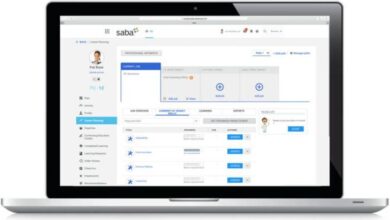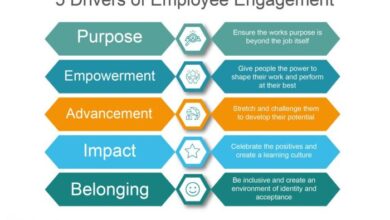
Employee motivation remote teams is crucial for success in today’s work environment. Remote work presents unique challenges compared to in-office settings, requiring tailored strategies for engagement and productivity. This guide explores the intricacies of motivating remote employees, from understanding their specific needs to fostering a sense of belonging and connection. We’ll delve into effective communication strategies, leadership approaches, and tools for collaboration, equipping you with the knowledge to create a thriving remote work culture.
This comprehensive exploration will cover remote team dynamics, motivational strategies, essential communication and collaboration tools, leadership practices, measuring motivation, fostering recognition, and overcoming common challenges. We’ll also compare different remote work models and provide actionable insights to improve employee engagement and overall team performance.
Understanding Remote Team Dynamics
Remote work has become increasingly prevalent, and with it comes a unique set of challenges in motivating and managing employees. Successfully navigating these challenges requires a nuanced understanding of remote team dynamics, particularly regarding communication, trust, and fostering a sense of belonging. This understanding allows for tailored strategies to boost productivity and maintain a positive work environment.Effective remote team management necessitates a shift in perspective from traditional in-office models.
The absence of spontaneous interactions and the need for proactive communication strategies highlight the importance of clear communication channels, feedback loops, and a focus on building a strong sense of community. A remote environment demands deliberate effort to create an inclusive and supportive atmosphere that mirrors the positive aspects of in-office interactions.
Unique Challenges in Motivating Remote Employees
Remote work presents specific hurdles compared to in-office environments. These challenges often stem from the lack of physical proximity, potentially leading to feelings of isolation or disconnection. Maintaining motivation in the absence of daily interactions and impromptu collaboration can be demanding. Furthermore, a lack of visual cues and shared experiences can make it harder to gauge employee morale and address potential issues promptly.
The lack of spontaneous interaction and collaboration requires structured communication and task management systems to ensure everyone stays on track.
Importance of Clear Communication and Feedback Mechanisms
Clear and consistent communication is paramount for remote teams. Regular check-ins, project updates, and dedicated channels for questions and concerns are crucial for keeping everyone informed and engaged. Moreover, establishing clear expectations for communication frequency and response times creates a sense of predictability and control. The need for detailed project documentation and accessible resources further underscores the importance of communication.
This includes creating clear guidelines for how and when to communicate, such as dedicated channels for specific types of communication.
Strategies for Fostering a Sense of Belonging and Connection
Building a strong sense of belonging is essential for motivating remote employees. Regular virtual team-building activities, online social events, and opportunities for informal communication can foster camaraderie and connection. Encouraging employees to share personal stories, interests, and hobbies through virtual platforms can help create a sense of community. Sharing team successes and acknowledging individual contributions publicly through company newsletters or virtual celebrations can create a sense of shared accomplishment and belonging.
Role of Trust and Autonomy in Motivating Remote Employees
Trust and autonomy are critical components of remote team motivation. Empowering employees with decision-making authority and providing flexibility in work arrangements fosters a sense of ownership and responsibility. Trusting employees to manage their time effectively and deliver results demonstrates confidence in their abilities. Open communication and trust are essential for creating a positive and productive work environment where employees feel comfortable taking initiative and working independently.
Examples of Successful Remote Team Building Activities
Virtual team lunches, online games, virtual escape rooms, and collaborative online projects are some examples of successful remote team-building activities. These activities foster interaction and create opportunities for employees to connect on a personal level outside of work tasks. Choosing activities aligned with team interests and preferences ensures engagement and fosters a sense of community. For instance, a team interested in cooking could participate in a virtual cooking competition, while those who enjoy games could partake in online trivia nights.
The goal is to create a positive environment that encourages employees to interact and develop camaraderie, regardless of their physical location.
Motivational Strategies for Remote Teams
Remote work is rapidly becoming the norm, and understanding how to motivate remote teams is crucial for success. Effective motivation strategies go beyond simply providing a paycheck; they encompass a multifaceted approach that addresses the unique needs and challenges of distributed teams. This requires a shift in perspective from traditional management styles to a more nuanced understanding of individual motivations and collaborative work processes.Remote employees often face isolation and a lack of spontaneous interaction, which can hinder morale and productivity.
Effective strategies recognize these challenges and focus on fostering a sense of belonging, purpose, and professional growth within a virtual environment. Building strong communication channels and providing opportunities for team bonding are vital for fostering a positive and productive remote work culture.
Key Motivational Factors for Remote Employees
Remote employees are motivated by different factors than their in-office counterparts. Recognition, autonomy, and opportunities for professional growth hold significant weight. Feeling valued for their contributions, having control over their schedules, and learning new skills are all strong motivators in a remote environment. A supportive work culture that fosters open communication and collaboration is essential to creating a sense of belonging and shared purpose.
Designing a Recognition and Reward Framework
Creating a structured system for recognizing and rewarding remote team members’ contributions is critical. Regular check-ins, acknowledging individual achievements, and offering meaningful rewards (beyond monetary) are key elements. This can include public praise on team platforms, opportunities for mentorship, or personalized certificates of appreciation. The key is to ensure the recognition is timely, specific, and visible to the entire team.
Importance of Professional Development Opportunities
Providing professional development opportunities is paramount for remote workers. This could include online courses, workshops, conferences, or mentorship programs. Continuous learning not only enhances skills but also demonstrates a commitment to employee growth, fostering a sense of value and investment. This is essential for maintaining high motivation and keeping remote teams engaged.
Creating a Supportive and Inclusive Remote Work Environment
Building a supportive and inclusive remote work environment requires deliberate effort. Clear communication channels, regular team meetings (with a focus on informal interaction), and providing tools and resources for remote collaboration are essential. Encouraging open dialogue and actively addressing any issues or concerns early on helps create a sense of belonging and psychological safety.
Leveraging Technology to Enhance Remote Team Engagement
Technology plays a vital role in enhancing remote team engagement. Utilizing video conferencing tools for regular check-ins and team meetings, collaborative platforms for project management and communication, and interactive tools for brainstorming and problem-solving can significantly improve team dynamics. Choosing the right technology and integrating it effectively are key.
Comparing Remote Work Models
| Model | Key Characteristics | Motivation Strategies | Challenges |
|---|---|---|---|
| Fully Remote | 100% remote work, employees located anywhere | Stronger emphasis on communication tools, virtual team-building activities, clear communication of company values, and personalized recognition. | Maintaining company culture, fostering spontaneous collaboration, and addressing potential isolation of employees. |
| Hybrid | Combination of remote and in-office work, employees split between locations | Blending in-person and virtual team-building activities, ensuring equitable opportunities for collaboration and recognition for both remote and in-office workers, and flexible scheduling options. | Balancing needs of remote and in-office employees, managing communication between different work environments, and maintaining a sense of shared experience across locations. |
Communication and Collaboration Tools
Staying connected and collaborating effectively is paramount for remote teams. Strong communication fosters a sense of community and shared purpose, even when geographically dispersed. This allows teams to brainstorm ideas, share knowledge, and work cohesively towards common goals. Without robust communication channels, productivity can suffer, and morale can decrease.Effective communication platforms are not just tools; they are the lifeblood of remote work.
They facilitate seamless information flow, enabling teams to stay informed, engaged, and aligned on projects. The right tools empower remote workers to contribute meaningfully, fostering a positive and productive work environment.
Importance of Effective Communication Platforms
Remote teams rely heavily on digital communication to maintain workflow and connection. Clear, concise, and timely communication ensures everyone is on the same page, reducing misunderstandings and delays. These platforms also facilitate quick responses to questions, allowing for immediate clarification and issue resolution. Strong communication platforms are vital for fostering a sense of team spirit and camaraderie, which is especially crucial for remote teams that might not have the opportunity for spontaneous in-person interactions.
Examples of Tools Facilitating Collaboration and Knowledge Sharing
Numerous tools are designed to streamline collaboration and knowledge sharing in remote teams. Project management software like Asana, Trello, or Monday.com allows teams to organize tasks, track progress, and communicate effectively. Similarly, shared document platforms like Google Docs or Microsoft Office 365 enable real-time collaboration on documents, presentations, and spreadsheets. Instant messaging platforms like Slack, Microsoft Teams, or Discord facilitate quick communication and ad-hoc discussions.
Video conferencing tools such as Zoom, Google Meet, or Microsoft Teams facilitate face-to-face interactions, promoting stronger relationships and clearer understanding. These tools, combined, empower remote teams to achieve high productivity and engagement.
Communication Tool Comparison
Effective remote work relies on selecting the right communication tools. Choosing the best tools requires understanding their strengths and weaknesses, as well as aligning them with team needs and workflows.
Leadership and Management Practices

Leading remote teams requires a unique approach compared to in-person teams. Effective leadership in this context hinges on fostering trust, clear communication, and a deep understanding of individual employee needs. Remote work environments demand proactive management to maintain engagement and productivity. Leaders need to adapt their styles to create a supportive and motivating atmosphere.Remote leadership is not simply a matter of replicating in-person management styles.
It necessitates a shift in focus to digital communication, flexible work arrangements, and the recognition of potential isolation. A leader who prioritizes these elements is more likely to see success in fostering a productive and motivated remote team.
Impact of Leadership Styles on Remote Employee Motivation
Different leadership styles resonate with different individuals. Autocratic leadership, while sometimes effective in specific situations, may not be ideal for remote teams where fostering independence and creativity is often desired. Transformational leadership, on the other hand, emphasizes collaboration, empowerment, and shared vision. This style, characterized by inspiring motivation and intellectual stimulation, can prove particularly valuable in fostering engagement in remote teams.
Democratic leadership styles, encouraging input from team members, can also contribute significantly to a positive work environment.
Effective Leadership Approaches for Remote Teams
Effective remote leadership encompasses several key strategies. Leaders should prioritize transparent communication, fostering open channels for feedback and discussion. Building trust is paramount, which can be achieved through consistent communication, active listening, and demonstrating empathy. Regular check-ins and opportunities for informal interaction can help bridge the distance and create a sense of connection.
Importance of Trust-Building and Open Communication
Trust is the cornerstone of any successful remote team. Managers should actively work to build trust by being reliable, demonstrating respect for team members’ time, and openly acknowledging and addressing concerns. Open communication channels, such as regular team meetings, instant messaging platforms, and dedicated forums for questions, are essential. Regular updates and transparency about project progress, challenges, and decisions build trust and maintain engagement.
Setting Clear Expectations and Goals
Clearly defined expectations and goals are crucial for remote teams. This involves outlining specific project deliverables, timelines, and roles. Regularly reviewing progress and providing constructive feedback are vital components of successful goal setting. Using project management tools, shared documents, and regular team meetings facilitates transparency and ensures everyone is on the same page.
Providing Regular Check-ins and Feedback
Regular check-ins are not just about monitoring progress; they are about nurturing employee well-being and addressing potential roadblocks. These check-ins should be flexible and allow for individual needs. Providing regular, constructive feedback, both positive and negative, is essential for continuous improvement and growth. Managers should actively solicit feedback from their remote team members to understand their challenges and ensure their success.
Measuring and Tracking Employee Motivation
Staying connected with remote employees is crucial for maintaining productivity and engagement. Effective monitoring of motivation allows for proactive interventions and adjustments to support remote team members’ well-being and performance. Regular feedback and progress tracking are essential tools for building a strong and successful remote workforce.Remote work requires a different approach to measuring and tracking employee motivation. Traditional methods may not be as effective, so innovative strategies are needed.
The key is to understand the unique challenges and opportunities presented by remote work and tailor strategies accordingly.
Methods for Measuring Employee Engagement
Understanding employee engagement is vital for effective management. Various methods can be employed to gauge the level of engagement among remote team members. These methods range from simple pulse surveys to more in-depth feedback sessions. Quantitative data, such as task completion rates and project milestones, alongside qualitative insights, offer a more comprehensive understanding of engagement. Employee surveys, feedback forms, and regular check-ins can also provide valuable information.
Tracking Progress Towards Goals and Objectives
Clear goals and objectives are essential for remote teams to stay focused and motivated. Tracking progress towards these goals requires a structured approach. Utilizing project management tools with features for task assignment, progress updates, and deadlines can effectively monitor progress. Regular check-ins and performance reviews provide opportunities to address any roadblocks or challenges and ensure team members remain on track.
Keeping remote teams motivated is a real challenge, isn’t it? It’s like trying to herd cats, but instead of hissing, they’re likely Zooming or Slacking. Think about how, in a similar vein, 35 years later earth finally returns ets phone call highlights the importance of communication across vast distances. Ultimately, effective communication and fostering a sense of community are key to reigniting that spark in any remote work environment.
Gathering Feedback from Remote Employees
Gathering feedback from remote employees is vital for understanding their needs and concerns. Implementing regular one-on-one meetings, feedback forms, and pulse surveys can provide valuable insights into motivation levels. Using tools that allow for anonymous feedback can encourage employees to share their honest opinions and concerns. Creating an open communication channel fosters a supportive environment where employees feel comfortable sharing their thoughts.
Key Performance Indicators (KPIs) for Remote Work Initiatives, Employee motivation remote teams
Identifying key performance indicators (KPIs) specific to remote work is essential for evaluating the success of remote work initiatives. These indicators should reflect the unique aspects of remote work, such as communication effectiveness, project completion rates, and employee satisfaction. Examples of KPIs include project completion rates, client satisfaction scores, and employee retention rates. Measuring these KPIs helps to identify areas where remote work processes can be improved and optimized.
Questions to Assess Remote Team Member Satisfaction and Motivation
Regularly assessing remote team member satisfaction and motivation is vital for maintaining a productive and engaged workforce. A structured approach, using well-defined questions, helps to understand the specific needs of remote employees. The questions should cover aspects like communication, work-life balance, and access to resources. The following list provides example questions for evaluating employee satisfaction and motivation.
- Do you feel adequately supported by your manager and the team?
- Do you have the resources you need to successfully complete your tasks?
- How would you rate the clarity of communication within the team?
- How satisfied are you with the work-life balance in your remote role?
- Do you feel your contributions are valued and recognized?
- Do you feel comfortable communicating any concerns or challenges?
- How satisfied are you with the tools and technology provided for remote work?
Fostering a Culture of Recognition
Remote work presents unique challenges in fostering a sense of belonging and appreciation. Team members spread across different time zones and locations might feel less connected and less visible than those in a traditional office setting. Creating a culture of recognition is crucial to combat this and ensure every remote employee feels valued and motivated. A well-structured recognition program can significantly boost morale and productivity.Recognition isn’t just about patting people on the back; it’s about acknowledging individual contributions, highlighting team successes, and fostering a culture of gratitude.
This proactive approach creates a positive feedback loop that encourages continuous improvement and strengthens team bonds. It goes beyond simply saying “thank you” and actively demonstrates the value each individual brings to the team.
Recognition Methods
Effective recognition strategies need to be tailored to the remote work environment. Simple, consistent acknowledgment of achievements can have a powerful impact. This can include verbal praise, written notes, or even shout-outs during team meetings. Using a shared platform to highlight accomplishments can create a sense of collective pride and inspire others. For instance, a dedicated channel on a project management tool could showcase successful project milestones, individual contributions, and team celebrations.
Creative Recognition Programs
Innovative recognition programs can further enhance the impact of appreciation. Consider a “Remote Rockstar” award, where team members nominate colleagues for exceptional work. This encourages peer-to-peer recognition and strengthens the sense of community. A “Remote Kudos” system, where employees can publicly acknowledge each other’s efforts with a simple comment or “thumbs up,” can be very effective in fostering a culture of gratitude.
Keeping remote teams motivated is a real challenge, isn’t it? It’s all about fostering a sense of connection and purpose. Think about how tiny innovations like eentsy capacitor could enable teentsier gadgets can lead to more compact, efficient devices. Similarly, we need to find innovative ways to connect and engage remote employees, ensuring they feel valued and part of the team, to boost their motivation and productivity.
A monthly “Spotlight on Success” feature in a team newsletter can showcase individual and team achievements, creating a sense of accomplishment for everyone. For example, a company might create a virtual “Hall of Fame” to celebrate significant accomplishments.
Implementing a Culture of Gratitude
A culture of gratitude isn’t just about recognition programs; it’s about creating a mindset where appreciation is ingrained in daily interactions. Leaders can model this behavior by frequently expressing gratitude for team members’ efforts. Encourage team members to express appreciation to each other through written notes, email, or informal communication channels. Create a dedicated space for expressing thanks, like a “thank you” thread on a team messaging platform.
For instance, a daily “gratitude check-in” via a brief team chat could help set a positive tone for the day.
Ensuring All Remote Team Members Feel Valued
Recognizing the diverse needs of remote employees is essential. Recognize the efforts of those who take initiative to connect with team members outside of work-related discussions. Consider providing opportunities for informal virtual gatherings and social events. This helps build camaraderie and fosters a sense of community. For instance, a virtual happy hour or online game night can foster team bonding.
Remote Team Building and Social Activities
Team building activities are crucial for maintaining morale and fostering strong connections in a remote environment. Virtual team lunches, online game nights, or even collaborative virtual projects can be engaging and help team members connect on a personal level. Organize virtual book clubs or watch parties for shared experiences. For instance, a company might create themed virtual scavenger hunts or trivia nights.
Keeping remote teams motivated is a real challenge, but it’s not impossible. Think about how the “x2x factor” – that crucial speed and efficiency aspect in data center migrations, as discussed in the x2x factor and the future of data center migration – can translate to remote work environments. Clear communication, fostering a sense of community, and providing flexible work arrangements are key to maintaining employee engagement and productivity in this new normal.
Regular virtual coffee breaks can be a simple way to foster informal interaction.
- Virtual Team Lunches: Scheduling a time for a virtual lunch can provide an opportunity for informal conversations and help team members get to know each other better.
- Online Game Nights: Organizing online game nights can create a fun and engaging atmosphere, promoting camaraderie and fostering stronger bonds.
- Virtual Book Clubs: Creating virtual book clubs can encourage shared experiences and stimulate discussions, allowing team members to connect over a common interest.
- Themed Virtual Scavenger Hunts: Organizing themed virtual scavenger hunts can be a fun and engaging activity that encourages collaboration and problem-solving skills.
- Regular Virtual Coffee Breaks: Scheduling regular virtual coffee breaks can foster informal interaction and create opportunities for team members to connect outside of work-related tasks.
Overcoming Challenges in Remote Motivation: Employee Motivation Remote Teams
Remote work has revolutionized the way we operate, offering flexibility and work-life integration. However, maintaining employee motivation in a distributed environment presents unique challenges. These obstacles, ranging from feelings of isolation to communication breakdowns, demand proactive strategies for effective leadership and management. This section explores key strategies for overcoming these hurdles.Remote work, while offering advantages, can also lead to feelings of isolation and decreased engagement.
Addressing these challenges requires a multi-faceted approach that fosters a sense of community and connection. Recognizing and mitigating these obstacles is paramount for creating a thriving remote work environment.
Identifying Common Obstacles to Employee Motivation
Remote work presents a variety of potential obstacles to employee motivation. Technical difficulties, inconsistent internet connectivity, and a lack of face-to-face interaction can all contribute to a decrease in morale. Furthermore, blurred work-life boundaries and a lack of clear communication channels can also create frustration and hinder productivity. Maintaining focus and engagement in a dispersed environment requires deliberate strategies to combat these challenges.
Addressing Feelings of Isolation and Loneliness
Feeling isolated is a significant concern for remote workers. Strategies to combat this include regular virtual team-building activities, such as online games, virtual coffee breaks, or themed online social gatherings. These activities foster a sense of community and camaraderie, which can help to alleviate feelings of loneliness and isolation. Creating dedicated communication channels for informal interactions can also help build stronger relationships.
For example, a dedicated Slack channel for casual discussions can foster a sense of belonging and connection.
Managing Conflicts and Disagreements
Conflicts and disagreements are inevitable in any workplace, and remote settings are no exception. Effective communication is crucial for resolving conflicts constructively. Establish clear communication protocols, encouraging open and honest dialogue. Implement mechanisms for addressing disagreements promptly and fairly, such as regular team check-ins or designated conflict resolution channels. Mediation or facilitation can be useful tools for navigating difficult conversations.
Maintaining Work-Life Balance for Remote Employees
Maintaining a healthy work-life balance is paramount for remote employees. Establish clear boundaries between work and personal time. Encourage employees to take regular breaks and utilize vacation time. Promote a culture of flexibility and trust, recognizing that personal commitments may sometimes impact work schedules. Implementing flexible work hours can be beneficial in accommodating diverse needs.
Promoting a Positive and Productive Remote Work Culture
A positive remote work culture fosters motivation and productivity. Emphasize recognition and appreciation for contributions. Establish clear expectations and guidelines for communication and collaboration. Encourage regular feedback and open communication channels to facilitate transparent interactions. This will promote a sense of belonging and support, making remote work a more positive and productive experience.
Summary

In conclusion, motivating remote teams requires a multifaceted approach that addresses the specific needs and dynamics of distributed workforces. By understanding the unique challenges, implementing effective communication strategies, fostering a supportive culture, and leveraging technology, organizations can cultivate highly engaged and productive remote teams. This guide provides a roadmap for creating a thriving remote work environment where employees feel valued, connected, and motivated to achieve shared goals.






